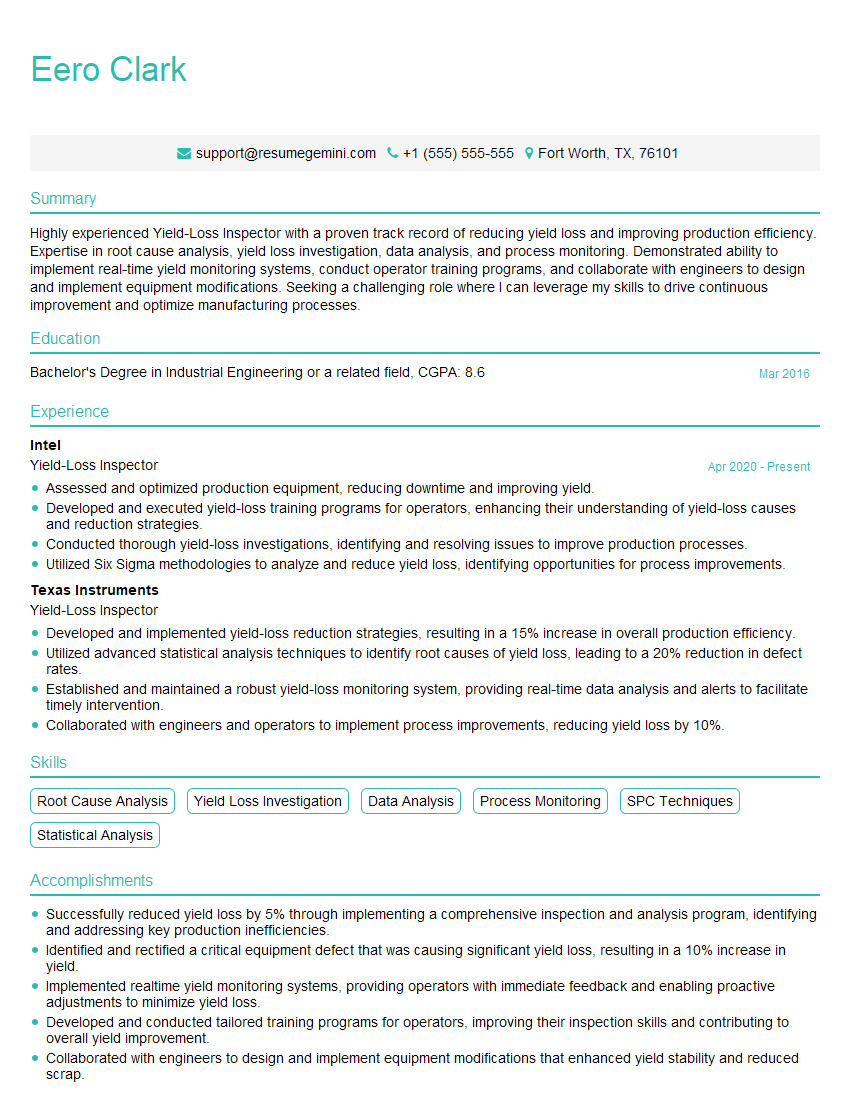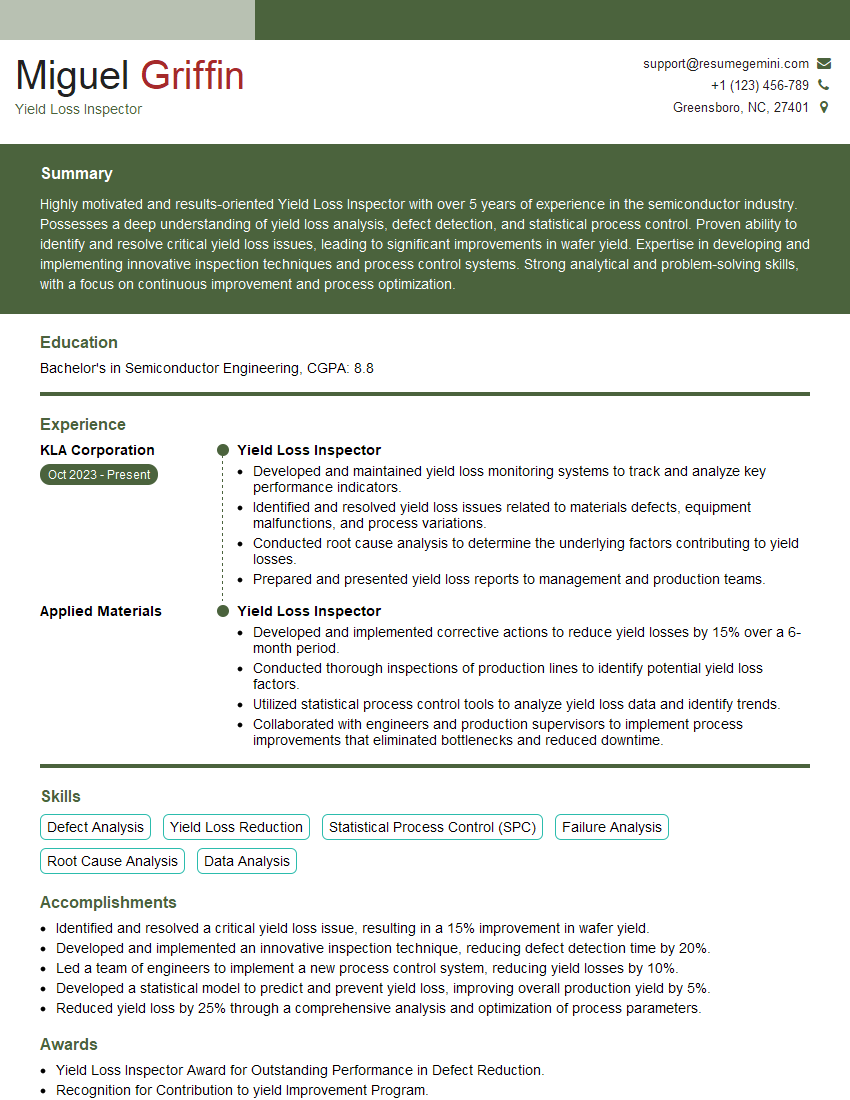Are you gearing up for a career shift or aiming to ace your next interview? Look no further! We’ve curated a comprehensive guide to help you crack the interview for the coveted Yield-Loss Inspector position. From understanding the key responsibilities to mastering the most commonly asked questions, this blog has you covered. So, buckle up and let’s embark on this journey together
Acing the interview is crucial, but landing one requires a compelling resume that gets you noticed. Crafting a professional document that highlights your skills and experience is the first step toward interview success. ResumeGemini can help you build a standout resume that gets you called in for that dream job.
Essential Interview Questions For Yield-Loss Inspector
1. Briefly explain your understanding of yield loss analysis?
Yield loss analysis is the process of identifying and quantifying the factors that contribute to the loss of yield in a production process. It helps to identify the root causes of yield loss and to develop strategies to reduce or eliminate them.
- Yield loss can occur at any stage of the production process, from raw material procurement to finished product delivery.
- There are a variety of factors that can contribute to yield loss, including equipment failures, process variations, and human error.
- Yield loss analysis can be used to identify the most significant factors contributing to yield loss and to develop strategies to reduce or eliminate them.
2. What are some of the common methods used for yield loss analysis?
- Pareto analysis: This is a statistical technique that helps to identify the most significant factors contributing to yield loss.
- Cause-and-effect analysis: This is a logical technique that helps to identify the root causes of yield loss.
- Statistical process control (SPC): This is a statistical technique that helps to monitor and control the production process to reduce yield loss.
3. What are some of the benefits of yield loss analysis?
- Improved product quality: Yield loss analysis can help to identify and eliminate the root causes of yield loss, which can lead to improved product quality.
- Increased productivity: Yield loss analysis can help to identify and eliminate the bottlenecks in the production process, which can lead to increased productivity.
- Reduced costs: Yield loss analysis can help to identify and eliminate the sources of waste in the production process, which can lead to reduced costs.
4. What are the challenges of yield loss analysis?
- Data collection: Yield loss analysis requires the collection of a large amount of data, which can be time-consuming and expensive.
- Data analysis: Yield loss analysis involves the analysis of a large amount of data, which can be complex and time-consuming.
- Implementation of solutions: The implementation of solutions to reduce yield loss can be challenging, as it may require changes to the production process or equipment.
5. What are some of the key performance indicators (KPIs) that you would use to measure the effectiveness of a yield loss analysis program?
- Yield: The yield is the ratio of the number of good products produced to the number of total products produced.
- Yield loss: The yield loss is the ratio of the number of defective products produced to the number of total products produced.
- Scrap rate: The scrap rate is the ratio of the number of defective products produced to the number of total products produced.
- Rework rate: The rework rate is the ratio of the number of products that are reworked to the number of total products produced.
- Downtime: The downtime is the amount of time that the production process is not operating due to equipment failures or other problems.
6. What are some of the best practices for conducting a yield loss analysis?
- Use a structured approach: Yield loss analysis should be conducted using a structured approach that includes data collection, data analysis, and the implementation of solutions.
- Use a team approach: Yield loss analysis should be conducted by a team of experts from different disciplines, such as engineering, production, and quality control.
- Use the right tools: There are a variety of tools available to help with yield loss analysis, such as statistical software and data collection software.
- Be patient: Yield loss analysis can be a complex and time-consuming process. It is important to be patient and to follow the process through to completion.
7. What are some of the latest trends in yield loss analysis?
- The use of big data: Big data can be used to collect and analyze a large amount of data to identify the root causes of yield loss.
- The use of machine learning: Machine learning can be used to identify patterns in data and to predict yield loss.
- The use of cloud computing: Cloud computing can be used to provide the computing power necessary to conduct yield loss analysis.
8. How do you stay up-to-date on the latest trends in yield loss analysis?
- Read industry publications: There are a number of industry publications that cover the latest trends in yield loss analysis.
- Attend industry conferences: Industry conferences are a great way to learn about the latest trends in yield loss analysis and to network with other professionals in the field.
- Take online courses: There are a number of online courses available that cover the latest trends in yield loss analysis.
9. Can you share a success story of a yield loss analysis project that you have worked on?
Here is a success story of a yield loss analysis project that I worked on:
- I was part of a team that conducted a yield loss analysis on a semiconductor manufacturing process.
- We used a variety of techniques, including Pareto analysis, cause-and-effect analysis, and SPC, to identify the root causes of yield loss.
- We implemented a number of solutions to reduce yield loss, including improving the quality of the raw materials, upgrading the equipment, and training the operators.
- As a result of our efforts, we were able to reduce yield loss by 20%, which resulted in a significant increase in profits.
10. What are your career goals?
My career goal is to become a world-renowned expert in yield loss analysis. I want to use my knowledge and skills to help companies improve their product quality, increase their productivity, and reduce their costs.
Interviewers often ask about specific skills and experiences. With ResumeGemini‘s customizable templates, you can tailor your resume to showcase the skills most relevant to the position, making a powerful first impression. Also check out Resume Template specially tailored for Yield-Loss Inspector.
Career Expert Tips:
- Ace those interviews! Prepare effectively by reviewing the Top 50 Most Common Interview Questions on ResumeGemini.
- Navigate your job search with confidence! Explore a wide range of Career Tips on ResumeGemini. Learn about common challenges and recommendations to overcome them.
- Craft the perfect resume! Master the Art of Resume Writing with ResumeGemini’s guide. Showcase your unique qualifications and achievements effectively.
- Great Savings With New Year Deals and Discounts! In 2025, boost your job search and build your dream resume with ResumeGemini’s ATS optimized templates.
Researching the company and tailoring your answers is essential. Once you have a clear understanding of the Yield-Loss Inspector‘s requirements, you can use ResumeGemini to adjust your resume to perfectly match the job description.
Key Job Responsibilities
Yield-Loss Inspectors play a critical role in manufacturing by identifying and eliminating sources of yield loss. Their key responsibilities encompass a wide range of functions, including:
1. Problem Identification and Troubleshooting
Conduct thorough inspections to identify defects, manufacturing errors, and other issues that affect product yield.
- Analyze production data, equipment performance, and environmental factors to pinpoint root causes of yield loss.
- Develop and implement corrective actions to eliminate defects and improve yield rates.
2. Process Optimization
Collaborate with engineers and production teams to identify and implement process improvements that enhance productivity and minimize yield loss.
- Review and revise operating procedures to optimize production processes and reduce defects.
- Monitor equipment performance, conduct preventive maintenance, and implement strategies to minimize downtime and maximize yield.
3. Data Analysis and Reporting
Collect and analyze yield data to identify trends, patterns, and areas for improvement.
- Prepare and present yield reports to management, highlighting key metrics, key performance indicators (KPIs), and opportunities for optimization.
- Use statistical tools and methodologies to analyze data and identify underlying causes of yield loss.
4. Compliance and Quality Assurance
Ensure compliance with quality standards and regulations by conducting audits and inspections.
- Review and update quality control procedures to meet industry standards and customer specifications.
- Monitor compliance with safety and environmental regulations.
Interview Tips
To ace your Yield-Loss Inspector interview, here are some tips and preparation strategies:
1. Research the Company and Industry
Gather information about the company, its products, and the industry in which they operate. This shows the interviewer that you’re interested in the company and have taken the time to learn about their business.
- Visit the company website and read industry publications.
- Connect with current or former employees on LinkedIn.
2. Practice Your Technical Skills
Demonstrate your technical proficiency by practicing the following skills:
- Identifying and troubleshooting manufacturing defects.
- Analyzing production data to identify yield loss patterns.
- Developing and implementing process improvements.
3. Emphasize Your Problem-Solving Abilities
Yield-Loss Inspectors are essentially problem-solvers. In your interview, highlight your ability to identify and resolve yield loss issues effectively.
- Provide specific examples of how you’ve solved problems in previous roles.
- Explain your analytical approach and how you use data to find solutions.
4. Showcase Your Communication Skills
Yield-Loss Inspectors need to be able to communicate effectively with engineers, production teams, and management. In your interview, demonstrate your:
- Ability to explain technical concepts clearly and concisely.
- Experience in presenting data and recommendations to stakeholders.
Next Step:
Armed with this knowledge, you’re now well-equipped to tackle the Yield-Loss Inspector interview with confidence. Remember, preparation is key. So, start crafting your resume, highlighting your relevant skills and experiences. Don’t be afraid to tailor your application to each specific job posting. With the right approach and a bit of practice, you’ll be well on your way to landing your dream job. Build your resume now from scratch or optimize your existing resume with ResumeGemini. Wish you luck in your career journey!

